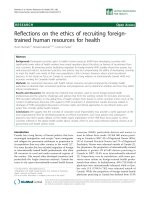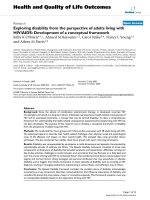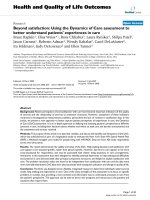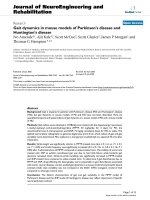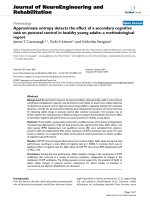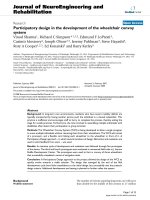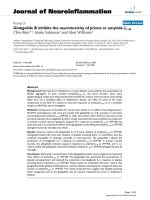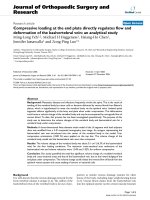Báo cáo hóa học: " Comment on “on the stability of quadratic double centralizers and quadratic multipliers: a fixed point approach” [Bodaghi et al., j. inequal. appl. 2011, article id 957541 (2011)]" pot
Bạn đang xem bản rút gọn của tài liệu. Xem và tải ngay bản đầy đủ của tài liệu tại đây (264.19 KB, 7 trang )
RESEARCH Open Access
Comment on “on the stability of quadratic
double centralizers and quadratic multipliers: a
fixed point approach” [Bodaghi et al., j. inequal.
appl. 2011, article id 957541 (2011)]
Choonkil Park
1
, Jung Rye lee
2
, Dong Yun Shin
3
and Madjid Eshaghi Gordji
4*
* Correspondence: madjid.
4
Department of Mathematics,
Semnan University, P. O. Box
35195-363, Semnan, Iran
Full list of author information is
available at the end of the article
Abstract
Bodaghi et al. [On the stability of quadratic double centralizers and quadratic
multipliers: a fixed point approach. J. Inequal. Appl. 2011, Article ID 957541, 9pp.
(2011)] proved the Hyers-Ulam stability of quadratic double centralizers and quadratic
multipliers on Banach algebras by fixed point method. One can easily show that all
the quadratic double centralizers (L, R) in the main results must be (0, 0). The results
are trivial. In this article, we correct the results.
2010 MSC: 39B52; 46H25; 47H10; 39B72.
Keywords: quadratic functional equation, multiplier, double centralizer, stability,
superstability
1. Introduction
In 1940, Ulam [1] raised the following quest ion concerning stability of group homo-
morphisms: Under what condition does there exist an additive mapping near an
approximately additive mapping? Hyers [2] answered the problem of Ulam for Banach
spaces. He showed that for Banach spaces
X
and
Y
,ifε >0and
f : X → Y
such
that
f (x + y) − f (x) − f (y) ≤ ε
for all
x, y ∈ X
, then there exists a unique additive mapping
T : X → Y
such that
f (x) − T(x) ≤ ε (x ∈ X ).
Consider
f : X → Y
to be a mapping such that f (tx)iscontinuousint Î ℝ for all
x ∈ X
. Assume that there exist constant ε ≥ 0 and p Î [0, 1) such that
f (x + y) − f (x) − f (y) ≤ ε( x ||
p
+ y ||
p
)(x ∈ X ).
Rassias [3] showed that there exists a unique ℝ-linear mapping
T : X → Y
such that
f (x) − T(x) ≤
2ε
2 − 2
p
x ||
p
(x ∈ X ).
Park et al. Journal of Inequalities and Applications 2011, 2011:104
/>© 2011 Park et al; licensee Springer. This is an Open Access article distributed under the terms of the Creative Commons Attribution
License ( which permi ts unrestricted use, distribution, and reproduction in any medium,
provided the original work is properly cited.
Găvruta [4] generalized the Rassias’ result. A square norm on an inner product space
satisfies the important parallelogram equality
x + y ||
2
+ x − y ||
2
=2( x ||
2
+ y ||
2
).
Recall that the functional equation
f (x + y)+f (x − y)=2f (x)+2f (y)
(1:1)
is called a quadratic functional equation. In particular, every solution of the func-
tional equation (1.1) is said to be a quadratic mapping. A Hyers-Ulam stability p ro-
blem for the quadratic functional equation was proved by Skof [5] for mappings
f : X → Y
,where
X
is a normed space and
Y
is a Banach space . Cholewa [6]
noticed that the theorem of Skof is still true if the relevant domain E
1
is replaced by
an Abelian group. Indeed, Czerwik [7] proved the Hyers-Ulam stability of the quadratic
functional equation. Since then, the stability problems of various functional equation
have been extensively investigated by a number of authors [8-20].
2. Stability of quadratic double centralizers
A linear mapping
L : A → A
is said to be left centralizer on
A
if L(ab)=L(a)b for all
a, b ∈ A
. Similarly, a linear mapping
R : A → A
satisfying that R (ab)=aR(b)forall
a, b ∈ A
is called right centralizer on
A
.Adouble centralizer on
A
is a pai r (L, R),
where L is a left centralizer, R is a right centralizer and aL(b)=R(a)b for all
a, b ∈ A
.
An operator
T : A → A
is said to be a multiplier if aT(b)=T(a)b for all
a, b ∈ A
.
Throughout this article, let
A
be a complex Banach algebra. Recall that a mapping
L : A → A
is a quadratic left centralizer if L is a quadratic homogeneous mapping,
that is quadratic and L(l a)=l
2
L (a) for all
a ∈ A
and l Î ℂ and L(ab)=L(a) b
2
for
all
a, b ∈ A
, and a mapping
R : A → A
is a quadratic right centralizer if R is a quad-
ratic homogeneous mapping and R(ab)=a
2
R(b) for all
a, b ∈ A
. Also a quadratic dou-
ble centralizer of an algebra
A
is a pair (L, R), where L is a quadratic left centralizer, R
is a quadratic right ce ntralizer and a
2
L(b)=R(a)b
2
for all
a, b ∈ A
(see [21] for
details).
It is proven in [8] that for vector spaces
X
and
Y
andafixedpositiveintegerk,a
mapping
f : X → Y
is quadratic if and only if the following equality holds:
2f
kx + ky
2
+2f
kx − ky
2
= k
2
f (x)+k
2
f (y).
We thus can show that f is quadratic if and only if for a fixed positive integer k,the
following equality holds:
f (kx + ky)+f (kx − ky)=2k
2
f (x)+2k
2
f (y).
Before proceeding to the main results, we will state the following theorem which is
useful to our purpose.
Theorem 2.1. (The alternative of fixed point [22]). Suppose that we are given a com-
plete generalized metric space (X, d) and a strictl y contractive mapping T: X ® X with
Lipschitz constant L. Then, for each given x Î X, either d(T
n
x, T
n+1
x)=∞ for all n ≥ 0
or other exists a natural number n
0
such that
Park et al. Journal of Inequalities and Applications 2011, 2011:104
/>Page 2 of 7
(i) d(T
n
x, T
n+1
x)<∞ for all n ≥ n
0
;
(ii) the sequence {T
n
x} is convergent to a fixed point y* of T;
(iii) y* is the unique fixed point of T in the set
= {y ∈ X : d(T
n
0
x, y) < ∞}
;
(iv)
d(y, y
∗
) ≤
1
1−L
d(y, Ty )
for all y Î Λ.
Theorem 2.2. Let
f
j
: A → A
be continuous mappings with f
j
(0) = 0 (j = 0, 1), and
let
φ : A
4
→ [0, ∞)
be continuous in the first and second variables such that
f
j
(λa + λb)+f
j
(λa − λb) − 2λ
2
[f
j
(a)+f
j
(b)] ≤φ(a, b,0,0),
(2:1)
f
j
(cd) − [(1 − j)(f
j
(c)d
2
)
1−j
+ j(c
2
f
j
(d))
j
]+u
2
f
0
(v) − f
1
(u)v
2
≤ φ(c, d, u, v)
(2:2)
for all
λ ∈ T =
{
λ ∈ C :
|
λ
|
=1
}
and all
a, b, c, d, u, v ∈ A
, j =0,1.If there exists a
constant m,0<m <1,such that
φ(c, d, u, v) ≤ 4mφ
c
2
,
d
2
,
u
2
,
v
2
(2:3)
for all
c, d, u, v ∈ A
, then there exists a unique quadratic double centralizer (L, R) on
A
satisfying
f
0
(a) − L(a) ≤
1
4(1 − m)
φ(a, a,0,0),
(2:4)
f
1
(a) − R(a) ≤
1
4(1 − m)
φ(a, a,0,0)
(2:5)
for all
a ∈ A
.
Proof. From (2.3), it follows that
lim
i
4
−i
φ(2
i
c,2
i
d,2
i
u,2
i
v)=0
(2:6)
for all
c, d, u, v ∈ A.
Putting j =0,l =1,a = b and replacing a by 2a in (2.1), we get
f
0
(2a) − 4f
0
(a) ≤φ(a, a,0,0)
for all
a ∈ A.
By the above inequality, we have
1
4
f
0
(2a) − f
0
(a)
≤
1
4
φ(a, a,0,0)
(2:7)
for all
a ∈ A.
Consider the set
X := {g | g : A → A}
and introduce the gener alized
metric on X:
d(h, g):=inf{C ∈
+
: g(a) − h(a) ≤ Cφ(a, a,0,0)foralla ∈ A}.
It is easy to show that (X, d) is complete. Now, we define the mapping Q : X ® X by
Q(h)(a)=
1
4
h(2a)
(2:8)
Park et al. Journal of Inequalities and Applications 2011, 2011:104
/>Page 3 of 7
for all
a ∈ A
.Giveng, h Î X,letC Î ℝ
+
be an arbitrary constant with d(g, h) ≤ C,
that is,
g(a) − h(a) ≤ Cφ(a, a,0,0)
(2:9)
for all
a ∈ A
. Substituting a by 2a in the inequality (2.9) and using (2.3) and (2.8),
we have
(Qg)(a) − (Qh)(a) =
1
4
g(2a) − h(2a)
≤
1
4
Cφ(2a,2a,0,0)
≤ Cmφ(a, a,0,0)
for all
a ∈ A
. Hence, d(Qg, Qh) ≤ Cm. Therefore, we conclude that d(Qg, Qh) ≤ md
(g, h) for all g, h Î X. It follows from (2.7) that
d(Qf
0
, f
0
) ≤
1
4
.
(2:10)
By Theorem 2.1, Q has a unique fixed point
L : A → A
in the set = {h Î X, d (f
0
, h)
< ∞}. On the other hand,
lim
n→∞
f
0
(2
n
a)
4
n
= L(a)
(2:11)
for all
a ∈ A
. By Theorem 2.1 and (2.10), we obtain
d(f
0
, L) ≤
1
1 − m
d(Qf
0
, L) ≤
1
4(1 − m)
,
i.e., the inequality (2.4) is true for all
a ∈ A
.Now,substitute2
n
a and 2
n
b by a and
b, respectively, and pu t j = 0 in (2.1). Dividing both sides of the resulting inequality by
2
n
, and letting n go to infinity, it follows from (2.6) and (2.11) that
L(λa + λb)+L(λa − λb)=2λ
2
L(a)+2λ
2
L(b)
(2:12)
for all
a, b ∈ A
and
λ
∈ T
. Putting l = 1 in (2.12), we have
L(a + b)+L(a − b)=2L(a)+2L(b)
(2:13)
for all
a, b ∈ A
. Hence, L is a quadratic mapping.
Letting b = 0 in (2 .13), we get L(la)=l
2
L(a) for all
a, b ∈ A
and
λ
∈ T
. By (2.13), L
(ra)=r
2
L(a) for any rational number r. It follows from the continuity f
0
and j for
each l Î ℝ, L(la)=l
2
L(a). Hence,
L(λa)=L
λ
| λ |
| λ | a
=
λ
2
| λ|
2
L(| λ | a)=
λ
2
| λ|
2
| λ|
2
L(a)
for all
a ∈ A
and l Î ℂ (l ≠ 0). Therefore, L is quadratic homogeneous. Putting j =
0, u = v = 0 in (2.2) and replacing 2
n
c by c, we obtain
f
0
(2
n
cd)
4
n
−
f
0
(2
n
c)
4
n
d
≤
1
2
4
−n
φ(2
n
c, d,0,0).
Park et al. Journal of Inequalities and Applications 2011, 2011:104
/>Page 4 of 7
By (2.6), the right-hand side of the above inequality tend to zero as n ® ∞. It follows
from (2.11) that L(cd)=L(c) d
2
for all
c, d ∈ A
. Thus, L is a quadratic left centralizer.
Also, one can show that there exists a unique mapping
R : A → A
which satisfies
lim
n→∞
f
1
(2
n
a)
4
n
= R(a)
for all
a ∈ A.
The same manner could be used to show that R is quadratic right cen-
tralizer. If we substitute u and v by 2
n
u and 2
n
v in (2.2), respectively, and put c = d =
0, and divide the both sides of the obtained inequality by 16
n
, then we get
u
2
f
0
(2
n
v)
4
n
−
f
1
(2
n
u)
4
n
v
2
≤ 16
−n
φ(0,0,2
n
u,2
n
v) ≤ 4
−n
φ(0,0,2
n
u,2
n
v).
Passing to the limit as n ® ∞, and again from (2.5) we conclude that u
2
L(v)=R(u)
v
2
for all
u, v ∈ A
. Therefore, (L, R) is a quadratic double centralizer on
A
. This com-
pletes the proof of the theorem.
3. Stability of quadratic multipliers
Assume that
A
is a complex Banach algebra. Recall that a mapping
T : A → A
is a
quadratic multiplier if T is a quadratic homogeneous mapping, and a
2
T(b)=T(a)b
2
for all
a, b ∈ A
(see [21]). We investigate the stability of quadratic multipliers.
Theorem 3.1. Let
f : A → A
be a continuous mapping with f(0) = 0 and let
φ : A
4
→ [0, ∞)
be a continuous in the first and second variables such that
f (a + λb)+f(λa − λb) − 2λ
2
[f (a)+f (b)] + c
2
f (d) − f(c)d
2
≤ φ(a, b, c, d)
(3:1)
for all
λ
∈ T
and all
a, b, c, d ∈ A.
If there exists a constant m,0<m <1,such that
φ(2a,2b,2c,2d) ≤ 4mφ(a, b, c, d)
(3:2)
for all
a, b, c, d ∈ A
. Then, there exists a unique quadratic multiplier T on
f (a) − T(a) ≤
1
4(1 − m)
φ(a, a,0,0)
satisfying
f (a) − T(a) ≤
1
4(1 − m)
φ(a, a,0,0)
(3:3)
for all
a ∈ A
.
Proof. It follows from j(2a,2b,2c,2d) ≤ 4mj(a, b, c, d) that
lim
n→∞
φ(2
n
a,2
n
b,2
n
c,2
n
d)
4
n
=0
(3:4)
for all
a, b, c, d ∈ A
. Putting l =1,a = b, c = d, d = 0 in (3.1), we obtain
f (2a) − 4f (a) ≤ φ(a, a,0,0)
for all
a ∈ A.
Hence,
f (a) −
1
4
f (2a)
≤
1
4
φ(a, a,0,0)
(3:5)
Park et al. Journal of Inequalities and Applications 2011, 2011:104
/>Page 5 of 7
for all
a ∈ A.
Consider the set
X := {h | h : A → A}
and introduce the generalized
metric on X :
d(g, h):=inf{C ∈
+
: g(a) − h(a) ≤ Cφ(a, a,0,0) foralla ∈ A}.
It is easy to show that (X, d) is complete. Now, we define a mapping F: X ® X by
(h)(a)=
1
4
h(2a)
for all
a ∈ A
. By the same reasoning as in the proof of Theorem 2.2, F is strictly
contractive on X. It follows from (3.5) that
d(f , f ) ≤
1
4
.
By Theorem 2.1, F has a
unique fixed point in the set X
1
={h Î X : d(f, h)<∞}. Let T be the fixed point of F.
Then, T is the unique mapping with T(2a)=4T(a), for all
a ∈ A
such that there exists
C Î (0, ∞) such that
T(x) − f (x) ≤ Cφ(a, a,0,0)
for all
a ∈ A
. On the other hand, we have lim
n ® ∞
d(F
n
(f), T )=0.
Thus,
lim
n→∞
1
4
n
f (2
n
x)=T(x)
(3:6)
for all
a ∈ A
. Hence,
d(f , T) ≤
1
1 − m
d(T, (f)) ≤
1
4(1 − m)
.
(3:7)
This implies the inequality (3.3). It follows from (3.1), (3.4) and (3.6) that
T(λa + λb)+T(λa − λb) − 2λ
2
T(a) − 2λ
2
T(b)
= lim
n→∞
1
4
n
T(2
n
(λa + λb)) + T(2
n
(λa − λb)) − 2λ
2
T(2
n
a) − 2λ
2
T(2
n
b)
≤ lim
n→∞
1
4
n
φ(2
n
a,2
n
b,0,0) =0
for all
a, b ∈ A.
Hence,
T(λa + λb)+T(λa − λb)=2λ
2
T(a)+2λ
2
T(b)
(3:8)
for all
a, b ∈ A
and
λ
∈ T
. Letting b = 0 in (3.8), we have T(la)=l
2
T(a), for all
a, b ∈ A
and
λ
∈ T
. Now, it follows from the proof of Theorem 2.1 and the continuity
f and j that T is ℂ-linear. If we substitute c and d by 2
n
c and 2
n
d in (3.1), respectively,
and put a = b = 0 and we divide the both sides of the obtained inequality by 16
n
,we
get
c
2
f (2
n
d)
4
n
−
f (2
n
c)
4
n
d
2
≤
φ(0,0,2
n
c,2
n
d)
16
n
≤
φ(0,0,2
n
c,2
n
d)
4
n
.
Passing to the limit as n ® ∞, and from (3.4) we conclude that c
2
T(d)=T(c)d
2
for
all
c, d ∈ A
.
Park et al. Journal of Inequalities and Applications 2011, 2011:104
/>Page 6 of 7
Author details
1
Department of Mathematics, Research Institute for Natural Sciences, Hanyang University, Seoul 133-791, Korea
2
Department of Mathematics, Daejin University, Kyeonggi 487-711, Korea
3
Department of Mathematics, University of
Seoul, Seoul 130-743, Korea
4
Department of Mathematics, Semnan University, P. O. Box 35195-363, Semna n, Iran
Authors’ contributions
All authors conceived of the study, participated in its design and coordination, drafted the manuscript, participated in
the sequence alignment, and read and approved the final manuscript.
Competing interests
The authors declare that they have no competing interests.
Received: 13 July 2011 Accepted: 1 November 2011 Published: 1 November 2011
References
1. Ulam, SM: Problems in Modern Mathematics, Chapter VI, Science edn. Wiley, New York (1940)
2. Hyers, DH: On the stability of the linear functional equation. Proc Nat Acad Sci USA. 27, 222–224 (1941). doi:10.1073/
pnas.27.4.222
3. Rassias, ThM: On the stability of the linear mapping in Banach spaces. Proc Am Math Soc. 72, 297–300 (1978).
doi:10.1090/S0002-9939-1978-0507327-1
4. Găvruta, P: A generalization of the Hyers-Ulam-Rassias stability of approximately additive mappings. J Math Anal Appl.
184, 431–436 (1994). doi:10.1006/jmaa.1994.1211
5. Skof, F: Propriet locali e approssimazione di operatori. Rend Sem Mat Fis Milano. 53, 113–129 (1983). doi:10.1007/
BF02924890
6. Cholewa, PW: Remarks on the stability of functional equations. Aequationes Math. 27,76–86 (1984). doi:10.1007/
BF02192660
7. Czerwik, S: On the stability of the quadratic mapping in normed spaces. Abh Math Sem Univ Hamburg. 62,59– 64
(1992). doi:10.1007/BF02941618
8. Eshaghi Gordji, M, Bodaghi, A: On the Hyers-Ulam-Rassias stability problem for quadratic functional equations. East J
Approx. 16, 123–130 (2010)
9. Eshaghi Gordji, M, Moslehian, MS: A trick for investigation of approximate derivations. Math Commun. 15,99–105
(2010)
10. Eshaghi Gordji, M, Rassias, JM, Ghobadipour, N: Generalized Hyers-Ulam stability of generalized (n, k)-derivations. Abstr
Appl Anal 8 (2009). Article ID 437931
11. Eshaghi Gordji, M, Khodaei, H: Solution and stability of generalized mixed type cubic, quadratic and additive functional
equation in quasi-Banach spaces. Nonlinear Anal TMA. 71, 5629–5643 (2009). doi:10.1016/j.na.2009.04.052
12. Kannappan, Pl: Quadratic functional equation and inner product spaces. Results Math. 27, 368–372 (1995)
13. Moslehian, MS, Najati, A: An application of a fixed point theorem to a functional inequality. Fixed Point Theory. 10,
141–149 (2009)
14. Najati, A, Park, C: Fixed points and stability of a generalized quadratic functional equation. J Inequal Appl 19 (2009).
Article ID 193035
15. Najati, A, Park, C: The pexiderized Apollonius-ensen type additive mapping and isomorphisms between C*-algebras. J
Diff Equa Appl. 14, 459–479 (2008). doi:10.1080/10236190701466546
16. Najati, A: Hyers-Ulam stability of an n-Apollonius type quadratic mapping. Bull. Belg Math Soc Simon Stevin. 14,
755–774 (2007)
17. Najati, A: Homomorphisms in quasi-Banach algebras associated with a pexiderized Cauchy-Jensen functional equation.
Acta Math Sin Engl Ser. 25(9), 1529–1542 (2009). doi:10.1007/s10114-009-7648-z
18. Lee, J, An, J, Park, C: On the stability of quadratic functional equations. Abstr Appl Anal 8 (2008). Article ID 628178
19. Baker, J: The stability of the cosine equation. Proc Am Math Soc. 80, 242
–246 (1979)
20. Eshaghi Gordji, M, Bodaghi, A: On the stability of quadratic double centralizers on Banach algebras. J Comput Anal
Appl. 13, 724–729 (2011)
21. Eshaghi Gordji, M, Ramezani, M, Ebadian, A, Park, C: Quadratic double centralizers and quadratic multipliers. Ann Univ
Ferrara. 57,27–38 (2011). doi:10.1007/s11565-011-0115-7
22. Diaz, J, Margolis, B: A fixed point theorem of the alternative for contractions on a generalized complete metric space.
Bull Am Math Soc. 74, 305–309 (1968). doi:10.1090/S0002-9904-1968-11933-0
doi:10.1186/1029-242X-2011-104
Cite this article as: Park et al.: Comment on “on the stability of quadratic double centralizers and quadratic
multipliers: a fixed point approach” [Bodaghi et al., j. inequal. appl. 2011, article id 957541 (2011)]. Journal of
Inequalities and Applications 2011 2011:104.
Park et al. Journal of Inequalities and Applications 2011, 2011:104
/>Page 7 of 7


